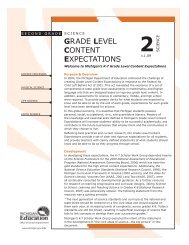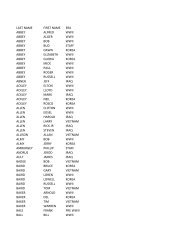Grade Level Content Expectations - State of Michigan
Grade Level Content Expectations - State of Michigan
Grade Level Content Expectations - State of Michigan
You also want an ePaper? Increase the reach of your titles
YUMPU automatically turns print PDFs into web optimized ePapers that Google loves.
ALGEBRA<br />
Understand and apply directly proportional relationships and<br />
relate to linear relationships<br />
A.PA.07.01 Recognize when information given in a table, graph, or formula suggests a directly<br />
proportional or linear relationship.*<br />
A.RP.07.02 Represent directly proportional and linear relationships using verbal descriptions,<br />
tables, graphs, and formulas, and translate among these representations.<br />
A.PA.07.03 Given a directly proportional or other linear situation, graph and interpret the slope<br />
and intercept(s) in terms <strong>of</strong> the original situation; evaluate y = mx + b for specific x values, e.g.,<br />
weight vs. volume <strong>of</strong> water, base cost plus cost per unit.*<br />
A.PA.07.04 For directly proportional or linear situations, solve applied problems using graphs<br />
and equations, e.g., the heights and volume <strong>of</strong> a container with uniform cross-section; height <strong>of</strong><br />
water in a tank being filled at a constant rate; degrees Celsius and degrees Fahrenheit; distance<br />
and time under constant speed.<br />
A.PA.07.05 Recognize and use directly proportional relationships <strong>of</strong> the form y = mx, and distinguish<br />
from linear relationships <strong>of</strong> the form y = mx + b, b non-zero; understand that in a directly<br />
proportional relationship between two quantities one quantity is a constant multiple <strong>of</strong> the other<br />
quantity.*<br />
Understand and represent linear functions<br />
A.PA.07.06 Calculate the slope from the graph <strong>of</strong> a linear function as the ratio <strong>of</strong> “rise/run”<br />
for a pair <strong>of</strong> points on the graph, and express the answer as a fraction and a decimal; understand<br />
that linear functions have slope that is a constant rate <strong>of</strong> change.<br />
A.PA.07.07 Represent linear functions in the form y = x + b, y = mx, and y = mx + b, and<br />
graph, interpreting slope and y-intercept.<br />
A.FO.07.08 Find and interpret the x and/or y intercepts <strong>of</strong> a linear equation or function. Know<br />
that the solution to a linear equation <strong>of</strong> the form ax+b=0 corresponds to the point at which the<br />
graph <strong>of</strong> y=ax+b crosses the x axis.*<br />
Understand and solve problems about inversely<br />
proportional relationships<br />
A.PA.07.09 Recognize inversely proportional relationships in contextual situations; know<br />
that quantities are inversely proportional if their product is constant, e.g., the length and<br />
width <strong>of</strong> a rectangle with fixed area, and that an inversely proportional relationship is<br />
<strong>of</strong> the form y = k/x where k is some non-zero number.<br />
A.RP.07.10 Know that the graph <strong>of</strong> y = k/x is not a line, know its shape, and know that it<br />
crosses neither the x nor the y-axis.<br />
Apply basic properties <strong>of</strong> real numbers in algebraic contexts<br />
A.PA.07.11 Understand and use basic properties <strong>of</strong> real numbers: additive and multiplicative<br />
identities, additive and multiplicative inverses, commutativity, associativity, and the distributive<br />
property <strong>of</strong> multiplication over addition.<br />
Combine algebraic expressions and solve equations<br />
A.FO.07.12 Add, subtract, and multiply simple algebraic expressions <strong>of</strong> the first degree,<br />
e.g., (92x + 8y) – 5x + y, or x(x+2) and justify using properties <strong>of</strong> real numbers.*<br />
A.FO.07.13 From applied situations, generate and solve linear equations <strong>of</strong> the form<br />
ax + b = c and ax + b = cx + d, and interpret solutions.<br />
* revised expectations in italics<br />
4 S E V E N T H G R A D E M A T H E M A T I C S ■ v. 1 2 . 0 5 ■ M I C H I G A N D E P A R T M E N T O F E D U C A T I O N






